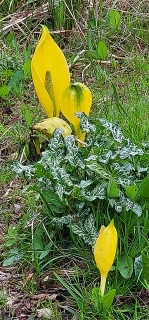Swamp Cypress and Skunk Cabbage in a park near Hampton Court
I ALWAYS ENJOY visiting Bushy Park, which is near to London’s famous Hampton Court Palace. Parts of the park are unenclosed, where plenty of deer roam at liberty. Other parts – the Pheasantry and Waterhouse plantations – are enclosed by fencing to keep the deer excluded.
The plantations contain a rich variety of plants and trees, all of which are a joy to see. There are two types of plants that never fail to fascinate me. One of these is the swamp cypress trees (Taxodium distichum). What makes them interesting is their aerial roots (known as ‘Cypress Knees’), which look like small woody stalagmites or tapering tree trunks. You can see rows of these stumpy aerial roots lining the stream near to the Pheasantry Café. According to a web article (www.graftingardeners.co.uk/trees-of-bushy-park/), these trees were:
“Once native to Britain, there have been ancient remains of this tree species found in Bournemouth. However, the swamp cypress was reintroduced to Britain by John Tradescant the Younger in 1640 … When the ground is particularly waterlogged, the swamp cypress tree grows pneumatophores. These are like knobbly woody stumps that grow out of the ground and serve as a sort of snorkel.”

Skunk Cabbage flowers
The other plant that stands out in my mind is known as Skunk Cabbage. With yellow flowers that slightly resemble Arum lilies, the Skunk Cabbage (Lysichiton americanus) is believed to emit an odour similar to that of skunks when it blooms. The smell is attractive to pollinators. The plant, although interesting to look at is a potential pest, as I found out on a website that deals with invasive species (www.invasivespecies.scot/american-skunk-cabbage):
“The large leaves and dense stands of the plant lead to it out-competing smaller plants due to its shading effect and can cause extensive damage locally to native flora including vascular plants and mosses. It can grow in shade or full-light and in a range of different soil conditions and thrives in disturbed environments. Given the popularity of this plant in gardens and its continued introduction into the wild, the problems are likely to increase. Although initial invasions will expand slowly, once this plant takes hold it can spread rapidly and become a serious problem.”
We saw the Skunk Cabbage in various stages from bud to full bloom when we visited Bushy today (the 24th of March 2024), but could not get close enough to the flowers to smell the odour from which they have got their name. I had noticed these plants before, but until today I did not know what they are.
Seeing curious plants such as the Swamp Cypresses and the Skunk Cabbage, which, incidentally, is edible if its root is roasted and dried, adds to the pleasure that is gained from seeing Bushy’s less strange plants such as daffodils, camellias, rhododendrons, and so on. Visiting the park and its gardens is well worthwhile, but get there early in the morning to ensure finding a place in the car parks.



